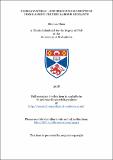'Homeawayness' : experiencing moments of home among Chinese labour migrants
Abstract
Migration is a major feature of contemporary human life, while making home is
ubiquitous. Being away from home creates a space for a migrant to rethink home and to
make a home beyond something fixed, spatial, and material. This thesis concerns home
and home making in the world of movement. It aims to investigate the ways in which
labour migrants make home on their journey away from home, a home through which
they express and fulfil themselves while making sense of the world.
Based on fieldwork in the Chaoshan region in South China, I approach individual
migrants from two practices of migration that have affected the region in the last 150
years: the historical international Nanyang (Southeast Asia) migration (1860s to 1970s)
and the contemporary internal rural-urban migration (1980s to present). Specifically, my
fieldwork includes participant observation through working in a toy factory with migrant
workers and living together with them for a year, as well as some months of archival
research of remittance family letters (qiaopi) in a local archive.
To study these two different strands of Chinese migration is not aimed primarily at
comparing or contrasting them; rather it is an attempt to explore the universal human
capacity to make home in a variety of ways beyond socio-cultural or historical constraint.
I argue that one experiences and makes sense of home in moments of being, while
making home, making self (and vice versa) is a continual process. One is constantly in a
process of self-negotiation, oscillating between identities that are being imposed and self-
recognised, between one’s reality and one’s imagination, between one’s past and one’s
future, and between one’s rootedness and one’s cosmopolitan openness.
I conclude the thesis by proposing five keywords for studying home-in-movement:
homeawayness, moments of being, interiority, cosmopolitan imagination, and walking
knowledge.
Type
Thesis, PhD Doctor of Philosophy
Collections
Items in the St Andrews Research Repository are protected by copyright, with all rights reserved, unless otherwise indicated.

